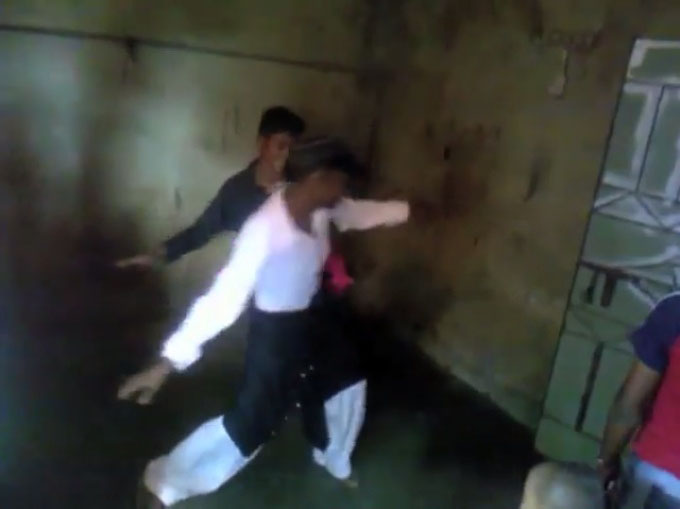
This November, the Tentative Collective’s project Mera Karachi Mobile Cinema began gathering cell phone videos from migrants living in Karachi. Produced in response to the question, “Home: What did you do last Sunday—anything fun?” the videos provide snapshots into migrant life in Pakistan’s largest city. When a substantial number of videos has been compiled, we will ask the community to help set up a series of free screenings in various parts of Karachi, using our rickshaw-powered projector to feature every video made by neighborhood residents.
It is ironic that of the roughly 2.5 million immigrants living in Karachi illegally, a majority used to be considered Pakistani themselves.
Karachi, like several other Asian megacities, has mushroomed in size because of migration—both legal and illegal—across national borders, and from country to city. The erection of borders across the Indian subcontinent has artificially separated highly mobile populations with shared ethnic and linguistic histories. The partition between India and Pakistan in 1947, and East Pakistan (now Bangladesh) and West Pakistan in 1971, created many more categories of outsiders or “migrants,” who have subsequently had to re-establish themselves on the basis of their new national belonging. These migrant identities carry with them a sense of insecurity, a new relationship to the land, and frequently, a lack of ownership in the temporary or irregular housing situations that many migrants occupy in megacities like Karachi.
The first communities we are working with are comprised of migrants from Bangladesh and Burma (including many of the persecuted Rohingya minority) and rural Pashtun migrants from the northern areas of Pakistan. Embedded within the Bengali/Burmese community are muhajirs (literally, “migrants”): Urdu-speaking Muslims who arrived from India after partition in 1947, and their descendants. Though the inception of Pakistan was based on the self-governance of a Muslim majority, inclusivity for Muslim migrants, and a space for minorities, the reality of Pakistan is riddled with ethnic and class complexities that divide the land into isolated zones and enclaves. This division extends to the public space surrounding these enclaves—whether they are irregular communities like the ones we are working in, or highly formalized, planned spaces.
I was introduced to Zebunnisa Ahmad by an urban scholar and adviser to our collective, Dr. Nausheen Anwar. Zebunnisa, or Zeb, was born in Karachi to a muhajir family. She is very politically active in her low-income community of Bengali and Burmese migrants. Even though she has lived in this community for more than five years, she thinks of herself as belonging to a different, and better, part of the city, and seems to position herself as an ethnographer of her neighborhood with dreams of escape. I asked Zeb to become a member of the Tentative Collective. She now collects videos from her neighbors for our project.
Returning to the irony of “illegal” Bengali migrants in Pakistan, few people recognize that the coastal borders of Burma and Bangladesh were geographically, ethnically and linguistically fluid zones. Hence, it is no surprise to see Burmese and Bengali migrants living in shared communities in Karachi. The loss of East Pakistan not only gave birth to Bangladesh but also further formalized the separation between Burmese-Rohingya migrants and their Bengali neighbors.
Noor-ul-Ameen is a rock star! Born in Karachi to a Burmese migrant family of fisherman, he seems bored by his familial profession. He lives two houses away from Zeb. On my last visit to his neighborhood, he said, “Noor Ameen is not here, I am someone else,” and then continued, “Take me with you.”
Nearly all of the migrants we have included in this project live in “irregular” settlements with high levels of violence and conflicted states of belonging. These areas are often ecological disaster zones because of a lack of state planning and tenure rights. As this writing becomes more personal, I want to reveal that I am a migrant in Karachi myself: a privileged one. I am a member of the Tentative Collective, a collective of people who share resources to create critical works of art in public places. While here I am gathering observations and organizing events in Bengali-Burmese, and Pashtun communities that I know little about through direct social experience. Despite being Pakistani, fluent in Urdu and careful about how I dress, I am often seen as a suspicious outsider in these areas.
I was born in an upper-middle-class neighborhood of Karachi. My parents, of Punjabi and Kashmiri origin, moved here in the 1970s from the Punjab province. At 19, I moved to the United States and incidentally adopted upstate New York as one of my homes. I return to Karachi as an outsider now: self-conscious of my ambiguous class, and hypersensitive to my surroundings. I can critique my romantic experience of the Karachi I’ve visited and worked in, but I can’t claim any ability to summarize its complexities.
While these videos are made by different people in distinct situations, a spirit of kinship connects them, revealing authentic multiplicities of experience and desires for belonging more than any claims to objective journalism.
This piece, commissioned by Creative Time Reports, has also been published by Art Asia Pacific.

